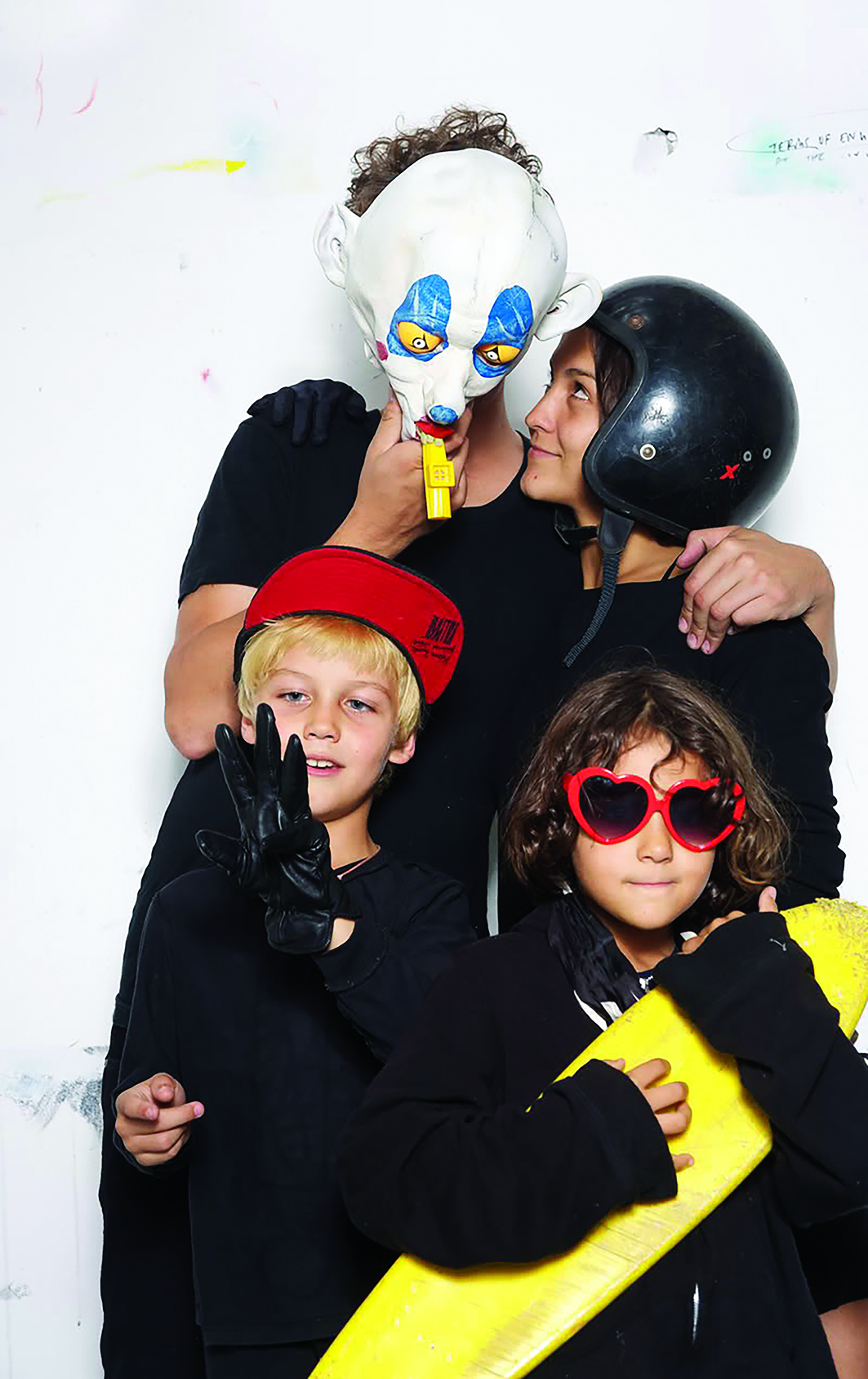‘I got this guy making a film that’s going to expose me for what I really am,’ Australian artist Anthony Lister said, in a 2016 interview. ‘He’s the guy that made that documentary, All This Mayhem.’[1]Anthony Lister, quoted in Kimberley Reynolds, ‘Creativity Without Boundaries, the Anthony Lister Interview’, Volcom official website, 17 October 2016, <https://www.volcom.com/truetothis/the-anthony-lister-interview/>, accessed 5 February 2018.
And so it has come to pass. Australian documentarian Eddie Martin, the ‘guy’ in question, follows up 2014’s All This Mayhem – the wild tale of the Pappas brothers, Greek-Australian kids from rough-as-guts western Melbourne who, in the 1990s, became skate-boarding superstars – with a film of similar narrative and twin spirit. Have You Seen the Listers? (2017) is another chronicle of a local street-culture superstar whose colourful life finds wild international success, a playful sense of recklessness, copious amounts of drugs, trouble with the law and, finally, a sense of redemption achieved through the process of making the documentary itself.
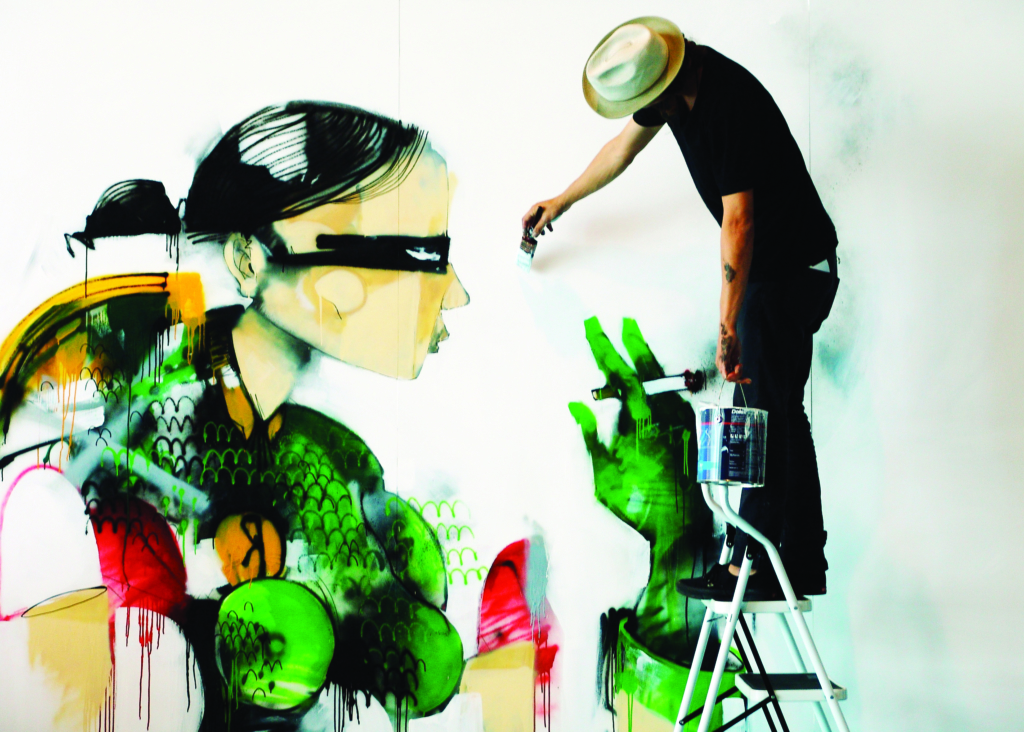
Martin’s first ever film, Jisoe (2005), hung out with local graffiti artist Justin Hughes, and Lister’s 2009 exhibition No Win Sitch – staged in the infamous Sydney red-light district of Kings Cross, in a disused strip club[2]See ‘No Win Sitch’, Anthony Lister official website, <https://anthonylister.com/web/portfolio-items/no-win-sitch/>, accessed 5 February 2018. – took its title from a line in Jisoe. [3]Dov Kornits, ‘Have You Seen the Best Film at MIFF?’, FilmInk, 19 August 2017, <https://filmink.com.au/seen-best-film-miff/>, accessed 5 February 2018. Lister himself doesn’t come from a background of graffing (‘Because he isn’t really a graffiti artist he tends to get a lot of hate from that scene,’ Martin says, ‘but since he isn’t a fine artist he also gets a lot of hate from that scene’[4]Eddie Martin, quoted in Kornits, ibid. ), the filmmaker approaching him as a figure more like ‘Keith Haring or [Jean-Michel] Basquiat’[5]Kornits, ibid. who straddles the worlds of street culture and art-world largesse, lowbrow and highbrow. ‘I’m drawn to protagonists that are on the fringe of the mainstream,’ Martin says, in his director’s statement. ‘Larrikins that dare to challenge the system and inspire. Australian artist Anthony Lister falls squarely in that category.’[6]Eddie Martin, ‘Directors Statement’, in Carver Films, Have You Seen the Listers? press kit, 2017, p. 6.
Whereas most films on famous artists are simple hagiographies – many mounted after the fact, often post-mortem, when the auction values of their artworks put their greatness beyond any narrative doubt – Have You Seen the Listers? is as much critique as tribute: a complex portrait of a conflicted central figure. Viewers may love to hate, or hate to love, the subject; by the end, though, they’ll understand, and empathise with, him. Lister’s half-joking comment about the documentary suggests an exposé. But, really, the resulting flick is closer to a tell-all: its narration cut together from interview confessionals, so much of its footage shot not by Martin (nor by cinematographer Simon J Walsh or cameraperson John Green), but by Lister himself. It’s a documentary of the digital age: there’s no need for celebrity talking heads when the subject has spent decades obsessively chronicling, and capturing, intimate moments in his life. There’s highs and lows (be they chemical or no); shows and no-shows; fatherhood and fuck-ups; and, always, art-making, in studios and on streets, the obsession of his videoing in sync with the monomania of his forever-painting ‘practice’.
It’s a documentary of the digital age: there’s no need for celebrity talking heads when the subject has spent decades obsessively chronicling, and capturing, intimate moments in his life.
After feeling out the filmmaker during the early making of the documentary, Lister, once trust was established, turned over his personal home-movie reserves: 750,000 video files, 12 terabytes worth.[7]ibid. Martin stitches together these unvarnished glimpses of Lister’s private life with newly shot footage of the artist at work – and working to get his life back together – on top of featuring a single talking head: the artist’s former partner, Anika. Her oft-critical presence, throughout, contributes greatly to the film’s conflicting portrayal of its subject, and to its qualities as a work beyond simple art worship. Anika – the mother of Lister’s three children, for whom the term ‘long-suffering’ surely applies – agreed to participate ‘because she wanted to give two sides to the story and to cut through the way Anthony is represented as this kind of mythical artist,’ Martin says.[8]Eddie Martin, quoted in Don Groves, ‘Artist Anthony Lister Bares His Soul in Eddie Martin’s Feature Documentary’, IF.com.au, 10 July 2017, <https://www.if.com.au/artist-anthony-lister-bares-his-soul-in-eddie-martins-feature-documentary/>, accessed 5 February 2018.
Have You Seen the Listers? opens with a voicemail message, heard out of context over a black screen. It’s the sound of Lister phoning his eldest child, Kye, by then a teenager; he’s effectively pleading for his son to call him back, to let him back into his life. It sounds an uneasy note on opening, suggesting that – despite the reams of happy-family home movies, the inevitable international art success, the crossing of paths with Paris Hilton[9]See, for example, sleepboy, ‘Anthony Lister x Paris Hilton’, Arrested Motion, 9 February 2009, <http://arrestedmotion.com/2009/02/anthony-lister-x-paris-hilton/>, accessed 5 February 2018. – things will not go well. But after that sad, strange opening, Martin gets things rolling in a fashion reminiscent of All That Mayhem’s rollicking pace: staging a montage of 1980s/1990s Australiana (Bob Hawke, Ken Done, Pope John Paul II holding a koala, a one-dollar note swapped for a one-dollar coin, A Country Practice, Sir Joh Bjelke-Petersen, the Fitzgerald Inquiry, the Brisbane Broncos winning a NSWRL premiership) set to The Choirboys’ Oz-rock classic ‘Run to Paradise’.
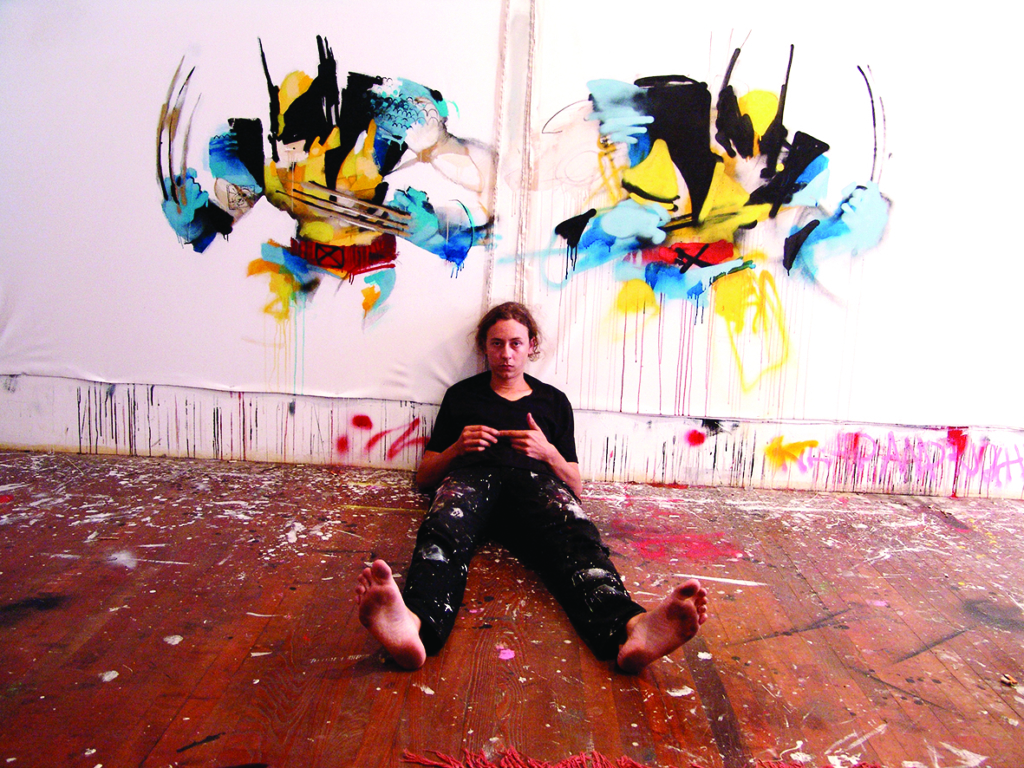
The montage evokes where Lister came from: born in 1979, he grew up in suburban Brisbane (‘the bum end of Nothingville’, he calls it in the film), one of three sons raised, by a single mother, on ‘after-school TV and two-minute noodles’. In a local news report, we witness his absent father, a taekwondo master running his own dojang, then we never see him again. ‘I didn’t really understand the meaning of “culture”, coming from Brisbane,’ Lister says, but a handful of influences – Mr. Squiggle, his grandmother, taking lots of acid, high school sweetheart Anika – inspired him to be an artist. The film then shows his beginnings painting 100 traffic signal boxes, commissioned by the Brisbane City Council after he presented a A$10,000 business plan, before going to art college at Griffith University (‘I was the only one of my family, on both sides, to even finish high school, let alone go to university’).
Two years out of high school, Anika becomes pregnant. After Kye is born, Lister leaves his family for the first time, heading to New York to apprentice under legendary Kiwi artist Max Gimblett. ‘I had a massive hard-on for New York,’ Lister says, in voiceover, in memorable turn of phrase. ‘We had this six-month-old baby; it was all fresh-as-hell days.’ Homesick, he returns to Brisbane, where the couple have their second child, Lola, and Lister stages his first ever solo show, Urbanised Influence, in 2001, at the age of twenty-one. The success of the show is a boon: he earns A$30,000 from selling paintings, and buys a house in Brisbane suburbia. These are, in the documentary’s framing, Lister’s halcyon days: endless home videos – kids gesturing at the camera and peering down its lens, Christmas mornings and horseplay, shirts off on hot summer days – showing a loving family, the artist driven towards commercial success by needing to support his growing brood. The Listers semi-whimsically move to New York, which means more home videos, only now with snow in the background, suburban Queenslander swapped for Brooklyn brownstone. For Lister, a functional family life was ‘extremely foreign’, and he felt ‘extremely insecure’ about being able to provide it. But, in a brisk eighty-six-minute picture, these happy-family moments don’t last for long.
In December 2006, he lands on the front page of The New York Times’ art section,[10]Anthony Lister’s CV as at May 2017, available at <http://nandahobbspollen.s3.amazonaws.com/80ab805ef56956203ceb846734d68c47.pdf>, accessed 5 February 2018. and a series of superhero paintings leads to a full-blown breakout. It’s here that Lister’s life kicks into overdrive, and those sweet salad days fall by the wayside. ‘As far as the timeline goes, it’s a bit of a blur. There was a lot of partying involved, and a lot of travelling,’ recalls Lister, in voiceover. ‘Everyone was doing drugs. Everyone was doing coke.’ When he gets arrested in New York for graffiti, Lister ends up spending the night in lock-up over Easter, the family once again celebrating a big occasion without him. They move back to Brisbane, but this just means that, as an international artist, he’s almost never home; Martin stages a montage of superhero shows, cash, drugs, vomit, hangers-on, heroising – poignantly crosscutting between globetrotting hi-so art shows and the kids left back home, spending carefree after-school afternoons in playgrounds and parks. Lister admits that ‘dealing with real parenthood’ was difficult, whereas the rest of his life – art-making, promotion, partying; videotaping all the while – came easily.
Martin betrays the obvious affection that he has for his subject – allows the documentary, as with the exhibition that shares its name, to become an act of contrition, a humbling of the egotistical art superstar, a film in service of real-world healing.
Anika decides, against Lister’s wishes, to have one more child, their daughter Polly (‘That was a very lonely, solitary decision,’ she reflects); this only pushes the ‘discord and disharmony’ in the relationship, such conflict running contrary to Lister’s artistic success, to the host of enablers and profiteers who burnish his burgeoning ego. A last-ditch effort to save the relationship involves travelling around the Australian coast in a campervan (‘I’m not much of a camping-type motherfucker,’ Lister says, ‘[but] it was kind of like our way to put the family back together’), this brief burst of happy-holiday videos interrupted when Lister gets a big show in Sydney, and moves the family into a downtown squat. Anika, eventually, finally, takes the kids and leaves, leading to further division – the art star repeating his own family history of absent-fatherhood.
Having lost the only relationship he’s ever known (‘I’d trained this family how to live without me, but I never trained myself how to live without them’), Lister turns to a downward cycle of drug use and cheap sex; even his art becomes a parade of corporate crossovers, made by someone who feels as if he’s become a cash cow for so many. ‘I made money, but it didn’t make me feel better,’ Lister offers.
I was depressed. I was trying to mend the situation, but it wasn’t mending. What d’you do when you’re going through a divorce, you’re bored out of your brain, you’re by yourself? Yeah, sure: coke, ice, speed, fucking speed, fucking marijuana.
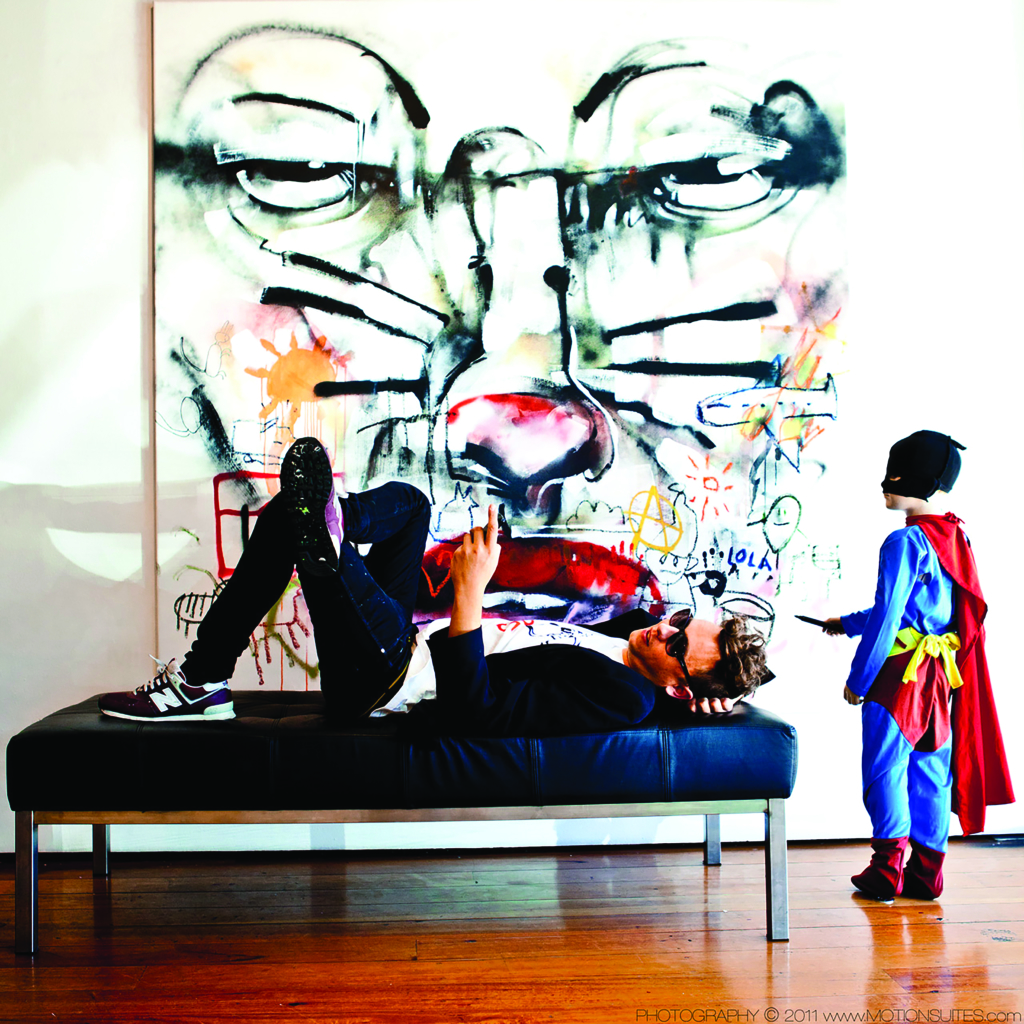
Martin gets to depict all this not just through hearsay, but through the video evidence Lister himself recorded. One montage shows glass pipes passed around, lines cut up and snorted, an endless parade of anonymous women – the subject, as time passes, looking ever more greasy and haggard, his tattoos proliferating wildly.
Things, though, go ‘from bad to worse’, recounts Lister. He is arrested, first, for ‘wilful damage’ for street-art pieces he created over the years in Brisbane – the same city that once paid him to paint it now making him a PR-minded example in its war on the ‘obscenity’ of graffiti. Then, he’s arrested for drug possession in Sydney, leading to public humiliation, the loss of contact with his kids, a possible fatal blow to his career (a drugs charge making future entry into the US unlikely) and a stint in a rehab facility in Bali. ‘It just seemed like rock bottom was just another opening for another rock bottom,’ Lister says.
From there, we witness Lister’s attempts to clear his name, to make amends, to reconnect with his kids. ‘It’s what I do from this point on that’s going to define what my children and the wider world think of me,’ he says. His drug charge is waived before he has to go to court, and, although he’s found guilty of wilful damage back in Brisbane – fined A$440 and forced to do community service – the media coverage of the case provides him a platform to become an advocate for ‘freedom of visual speech’. ‘It ended up costing me [A]$78K in lawyer fees, but I still have my integrity, and most importantly, my freedom,’ Lister offers.[11]Lister, quoted in Reynolds, op. cit.
It’s at this point – with the same pleading phone message that opened the film – that the history of Lister merges with the narrative-now, Martin following the artist as he prepares for his latest solo exhibition, Have You Seen the Listers?, show and movie sharing the same name. This work is an elaborate mea culpa, a grand public gesture aimed to win back the love and admiration of his estranged kids, set up in the park near their house: pictures pasted on a spray-painted inflatable castle, with canvases hung between trees. There’s paintings of his kids, the family dog, tender piano music on the score and, finally, moments of him bonding, lovingly, with daughters Lola and Polly.
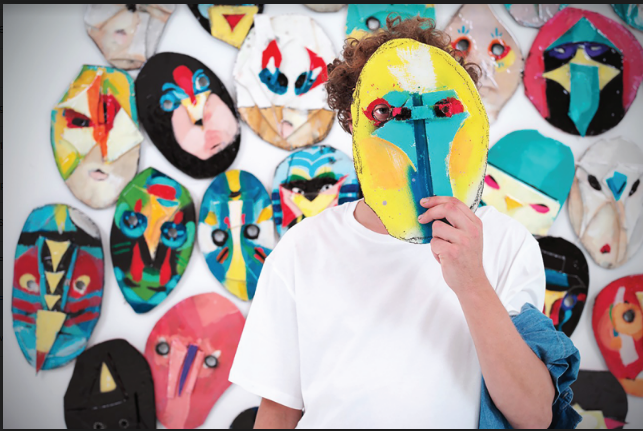
Martin then stages another montage: intimate, beautiful, ridiculous, rambunctious video footage of the Lister kids through the years – often, pointedly, poignantly, of them interacting with their loving father. ‘There’s a lot that happens in life, but there’s only handfuls of real memories,’ Lister says, ad hoc interviewees turned into poetry as it’s matched to image and music. ‘What I hope is that my kids have got more memories of me than I do of my dad. And I hope that those memories are big and strong.’ In these scenes, Martin betrays the obvious affection that he has for his subject – allows the documentary, as with the exhibition that shares its name, to become an act of contrition, a humbling of the egotistical art superstar, a film in service of real-world healing. Have You Seen the Listers? does expose Lister for what he really is, but what that is is complicated, messy, human.
The guy who made that documentary, All This Mayhem, has made another compelling work, one in which the collaboration between subject and observer enriches the project, as opposed to simplifying it. It’s the story of one man’s life, written by another. ‘It’s been a long road, Eddie,’ Lister says, in the film’s final moments. ‘It’s been a long, long road, mate.’
Endnotes
| 1 | Anthony Lister, quoted in Kimberley Reynolds, ‘Creativity Without Boundaries, the Anthony Lister Interview’, Volcom official website, 17 October 2016, <https://www.volcom.com/truetothis/the-anthony-lister-interview/>, accessed 5 February 2018. |
|---|---|
| 2 | See ‘No Win Sitch’, Anthony Lister official website, <https://anthonylister.com/web/portfolio-items/no-win-sitch/>, accessed 5 February 2018. |
| 3 | Dov Kornits, ‘Have You Seen the Best Film at MIFF?’, FilmInk, 19 August 2017, <https://filmink.com.au/seen-best-film-miff/>, accessed 5 February 2018. |
| 4 | Eddie Martin, quoted in Kornits, ibid. |
| 5 | Kornits, ibid. |
| 6 | Eddie Martin, ‘Directors Statement’, in Carver Films, Have You Seen the Listers? press kit, 2017, p. 6. |
| 7 | ibid. |
| 8 | Eddie Martin, quoted in Don Groves, ‘Artist Anthony Lister Bares His Soul in Eddie Martin’s Feature Documentary’, IF.com.au, 10 July 2017, <https://www.if.com.au/artist-anthony-lister-bares-his-soul-in-eddie-martins-feature-documentary/>, accessed 5 February 2018. |
| 9 | See, for example, sleepboy, ‘Anthony Lister x Paris Hilton’, Arrested Motion, 9 February 2009, <http://arrestedmotion.com/2009/02/anthony-lister-x-paris-hilton/>, accessed 5 February 2018. |
| 10 | Anthony Lister’s CV as at May 2017, available at <http://nandahobbspollen.s3.amazonaws.com/80ab805ef56956203ceb846734d68c47.pdf>, accessed 5 February 2018. |
| 11 | Lister, quoted in Reynolds, op. cit. |
